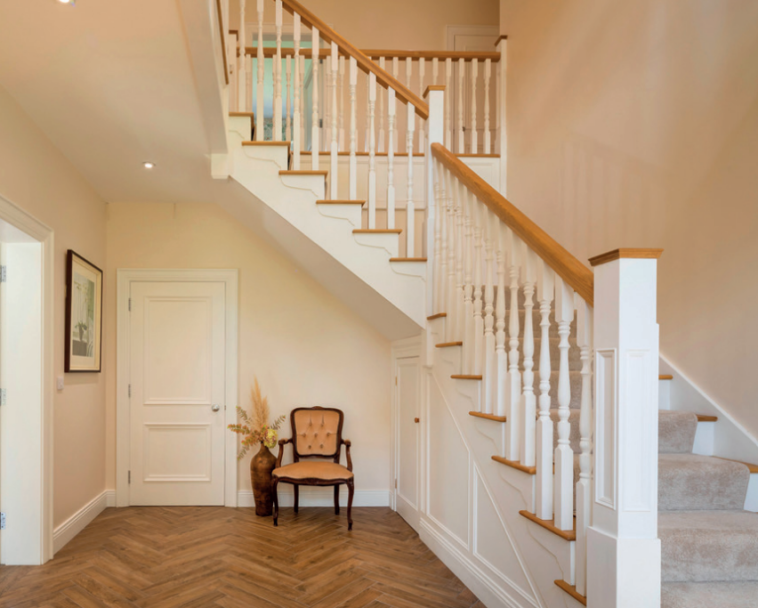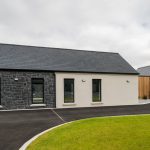What you can expect to pay in joinery costs in Ireland today, including staircases, internal doors and inbuilt units.
In this article we cover:
- The cost of building a staircase
- The cost of finishing a staircase
- The cost of balustrades, handrails and newel posts
- The cost of internal doors and ironmongery
- The cost of internal screens
- The cost of inbuilt units
- The cost of wardrobes
- Cost comparison with our previous cost analysis three years ago
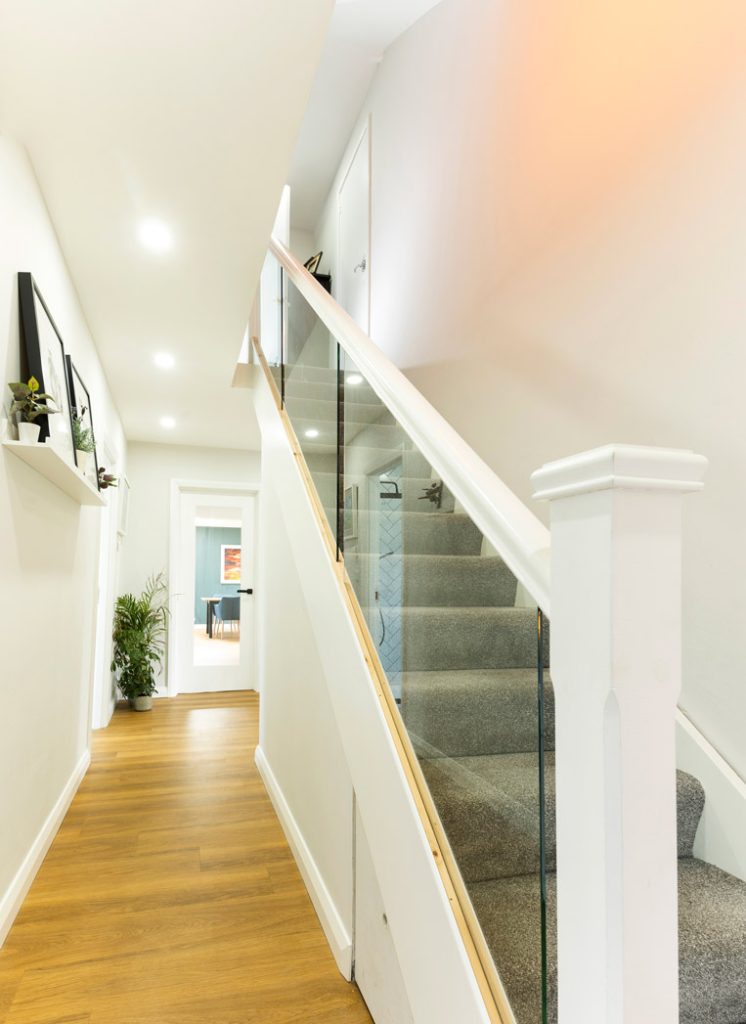
Joinery costs: staircase structure
The size, shape, position and layout of staircases, which taken with material choices, will lead to a variety of cost outcomes. The combined effect can result in a finished staircase costing less than €2,000/£1,800 to a piece of bespoke furniture costing in excess of 100,000 euros or pounds.
There are two cost components to the structure, material selection and the layout or shape. The most common choice of material has always been timber, with MDF at the lower end, pine in the midrange and up to solid oak, walnut or mahogany at the higher end.
On a simple standard straight flight of stairs, the cost difference between an MDF staircase and a solid staircase would go into the thousands of euros or pounds. A standard MDF staircase structure will cost less than €500/£450 for a straight single flight whereas a hardwood standard structure will cost over three times that.
The selection of which timber material you choose will directly have an impact on the cost of the staircase structure and will also dictate many of the costs that follow.
It is generally the case that the lower down the order of materials you select, the more likely it will be that a carpet or similar finish will dress the structure. This is generally always the case when it comes to MDF and often with pine or deal, but it is not unusual to see a solid pine staircase left exposed with a varnish.
A carpet finish on a standard straight run can be achieved for less than €1,000/£900 including the landing. For the more expensive exposed timber staircases it’s not unusual to have a varnished finish throughout or a mixture of varnish and the addition of a carpet runner to the centre of the stairs.
It is also now relatively common for the top of each step (thread) to be a different material like a walnut or oak and the remainder of the staircase pine or similar type material which is painted in a light colour.
Another common option for the structure is concrete which can be precast (fabricated off site and delivered and lifted into position) or cast in-situ (on location) where it is formed and poured onsite. The main benefit of a concrete staircase is longevity and the fact that it will not creak or move over time.
A concrete staircase will cost substantially more than timber with costs starting from over €1,500/£1,400 for a straight flight, working up from there depending on the design.
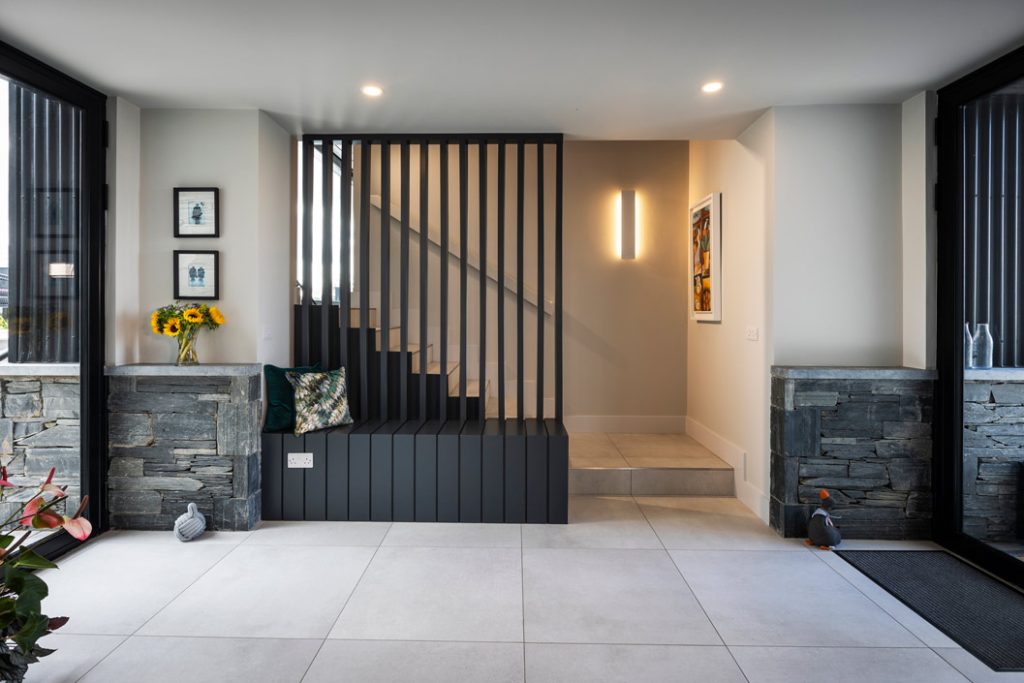
Staircase finishes
Apart from the cost of the structure itself, a further financial downside to a concrete staircase
is the additional cost of each step generally requiring a further element of finishing works. Oftentimes each step is clad in a carpet, timber or tile and the cost of these finishes can work into the thousands depending on material, size and shape of the staircase.
Not as common as timber and concrete, metal staircases are another option, for external use or an industrial style. The cost for the structure only would generally be less than concrete but more than timber.
Probably the most important cost component of the structure is its layout or shape. Placing the staircase between two walls negates the need to dress the sides and remains the most cost effective method.
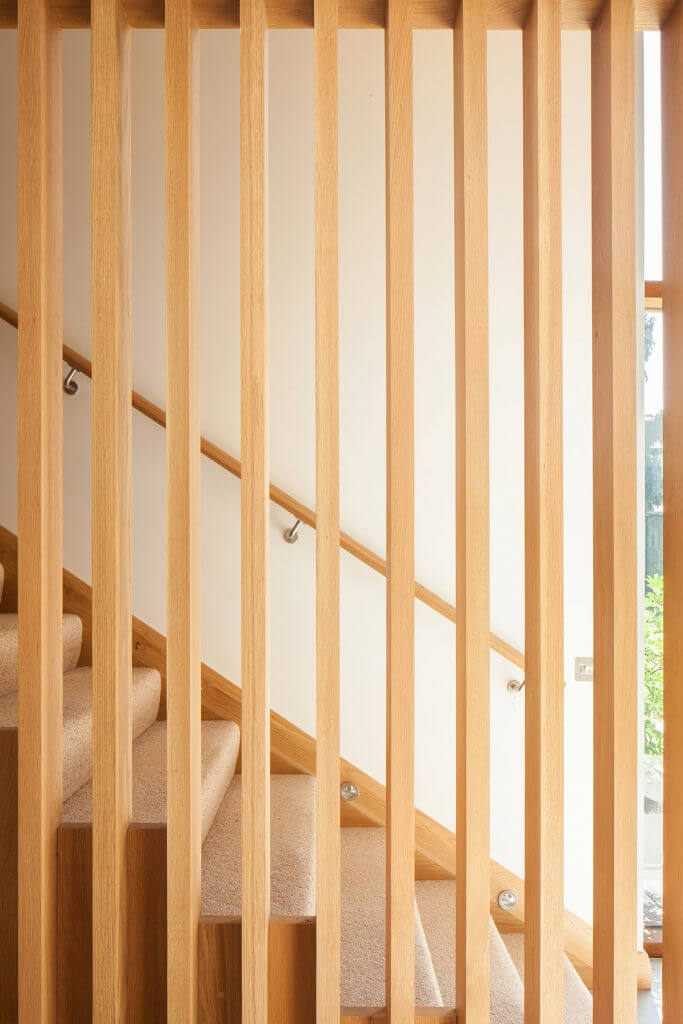
With more emphasis on maximising space, it is not unusual to now find staircases with half flights and intermediate landings. While this type of design may reduce the staircase’s footprint, it doubles the cost because instead of a single flight structure there are now two with an additional landing. This results in an increase in the number of parts as well as additional labour.
Arguably the most popular design today is to have a staircase structure that is visually exposed on one of both sides, again adding to the cost because these areas need to be finished with a decorative string detail. This will also add additional cost to the staircase in terms of balustrades and handrails.
The most expensive type of staircase layout is the curved staircase. The cost of the structure coupled with the material selection can be over 10 times the cost of a straight flight of stairs but this often results in a far more impactful design.
Balustrades, handrails and newel posts
A staircase built between two walls has no requirement for balustrades or newel posts and will most likely only require a handrail to be installed directly onto the wall, reducing costs.
Depending on the material selected for the handrail this can cost from a few hundred euros or pounds to less than a thousand for a finished hardwood. As before, material selection is all important with options generally including stud partitions, timber, glass and metal.
Depending on the material, the design, size and number of spindles, costs of completing a staircase in timber can range from less than €1,000/£900 for standard pine to over €5,000/£4,500 for more decorative hardwoods.
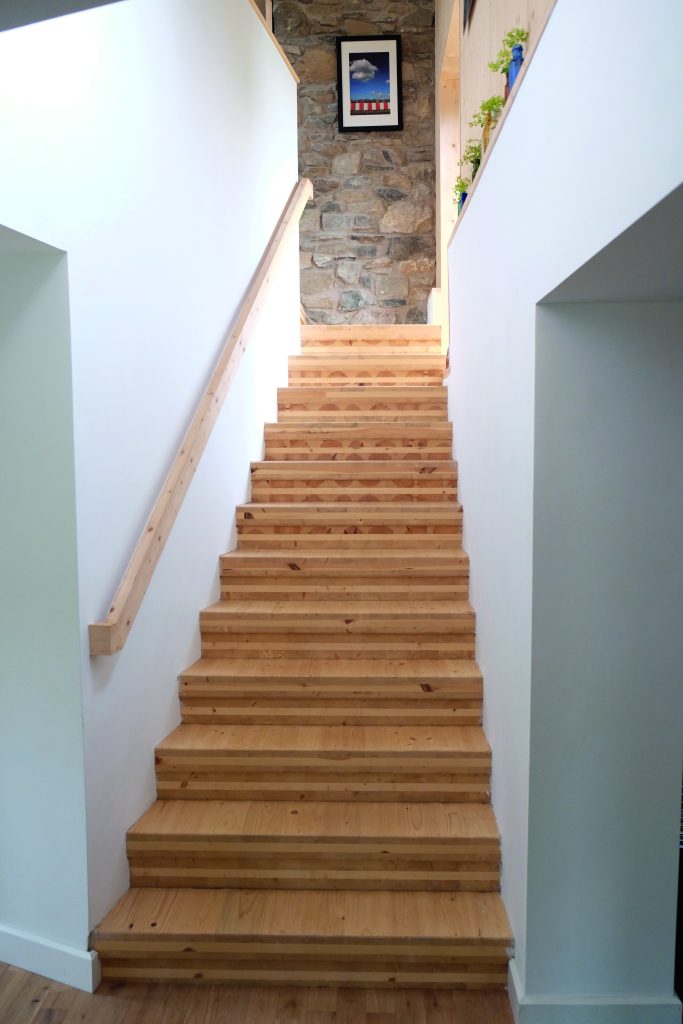
In recent years glass balustrades have grown in popularity but this comes at a price. With glass comes the necessity for fixings which are generally stainless steel. For safety reason the glass must be laminated and it’s not unusual for the glass balustrade to cost upwards of €1,000/£900 per metre run of railing.
Metalwork although less popular than the other options, is an expensive finish which usually involves high levels of detailing which generally requires site welding and finishing. It can come in a painted standard mild steel up to a high end finish like stainless steel.
Again depending on detail, shape and overall design, it’s likely that metalwork will work out as expensive as glass. It is also regularly found combined with glass, particularly stainless steel. A stainless steel and glass balustrade will be in excess of €1,500/£1,400 per metre run.
Joinery costs: door setup and finishes
Internal doors in domestic properties come in very many materials, shapes, sizes, colours and textures. In the main the cost of a door will include the frame, the architrave and the ironmongery which fixes the parts together.
It’s important to first understand that irrespective of the finish, the manner in which a door is supplied will impact on the labour cost of fitting. In general doors will come in one of two ways: pre-hung on a prefabricated frame ready to be directly installed into an opening, or more common on self-builds it will be supplied unassembled and the on site installation will include routing for hinges, locks and cutting and forming the frame to the required size.
The cost of a door can vary greatly depending on a number of factors but €150/£130 is a common starting point for doors assembled by a joiner on site, working up from that point depending on selections. A door on its own will cost far less but you need to factor in frame, ironmongery and labour.
Should a solid door be selected, this will most likely be made in a bespoke fashion by a joiner and the costs will rise to in excess of €650/£600 for a door and frame.
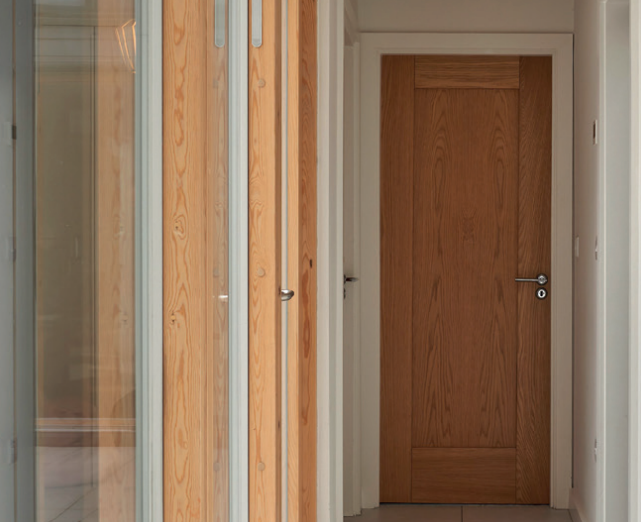
Sliding doors will be about as expensive as unassembled doors due to the need to install guide rails and other specialist fixings. Then it’s pro rata for double and multiple doors. The finish of a door will generally be at its cheapest for a primed or standard white door and it will increase for prefinished oak, walnut or similar. As the majority of doors now available in the marketplace are engineered doors, the door finish is a veneer on a timber frame with a filled core.
Ironmongery includes the hinges, handles, locks, door closers, door stops and similar items necessary to complete a door. Like many other aspects of finishes, it is a difficult task to choose among what is a wide range of options, from stainless steel to chrome to brass to black to different locking mechanisms. The cost of ironmongery can vary from less than €50/£40 per door to well in excess of €100/£90 per door depending on the brand and finish.
A fire door will generally cost more than a standard door of similar size but in many instances it is now possible to get primed white fire doors at entry level prices.
Increasingly, large screen type windows are replacing walls to allow light to flow through a building whilst maintaining room separation. Screens can be hardwood or softwood, and they come with a range of fire rated and non rated glazing possibilities. The cost of a screen will very much depend on its function and finish but will likely cost in excess of €550- 600/£550 per sqm.
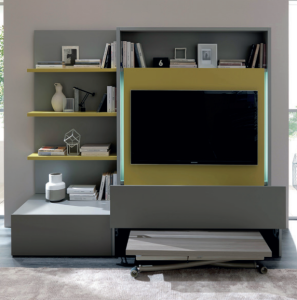
Joinery costs: inbuilt units
Wardrobes, TV Units, side boards, dressers, understair storage units. The costs of these units will vary depending on material, finish, amount of or existence of glazing and the functionality of the unit itself. Often made from similar carcasses to kitchen units it’s common to see units made from chipboard, MDF and solid timber. Costs will increase as you move up this scale.
On items like wardrobes, the selection of door types (solid or glass), the addition of drawers, the inclusion of mirrors, and the variety of accessories from shoe holders to tie racks and the likes will all work to detail the end cost of the unit. In budgeting terms it is not unusual to have wardrobes costs averaging at around €1,000/£900 per m of wardrobe.
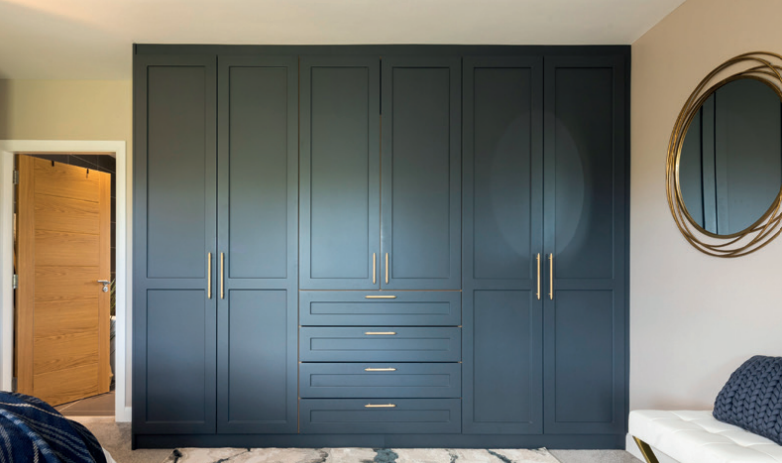
Window boards, window framing (similar to liners and architraves), window shutters, radiator cabinets and other smaller items are all joinery elements that may find their way into your build. Like all of the joinery items outlined above, the costs are very much down to material selection and finish and these items should be properly budgeted from the outset.
Cost notes: Since our overview three years ago, cost ranges are approximately the same but get at least three quotes for comparisons.







